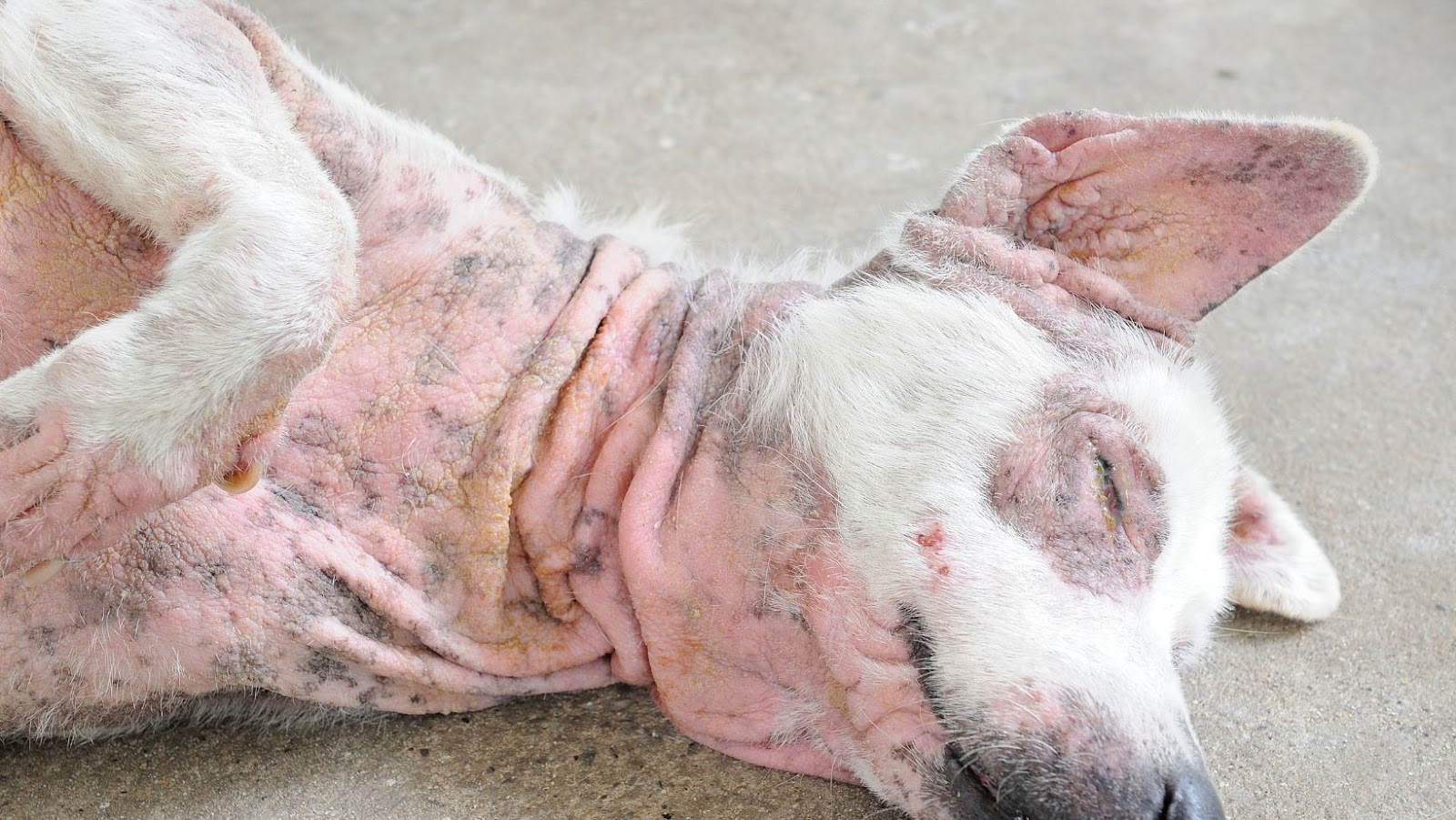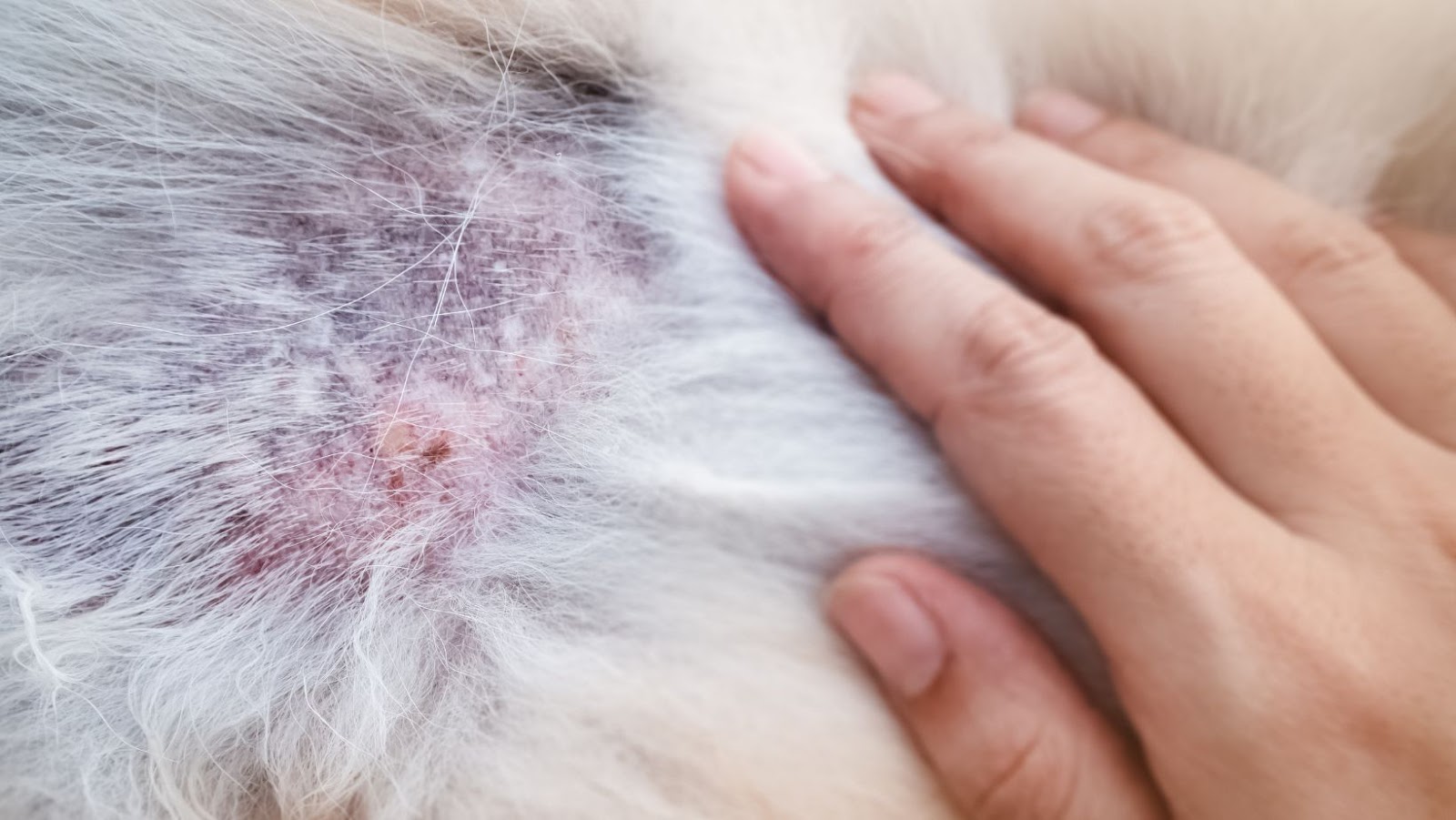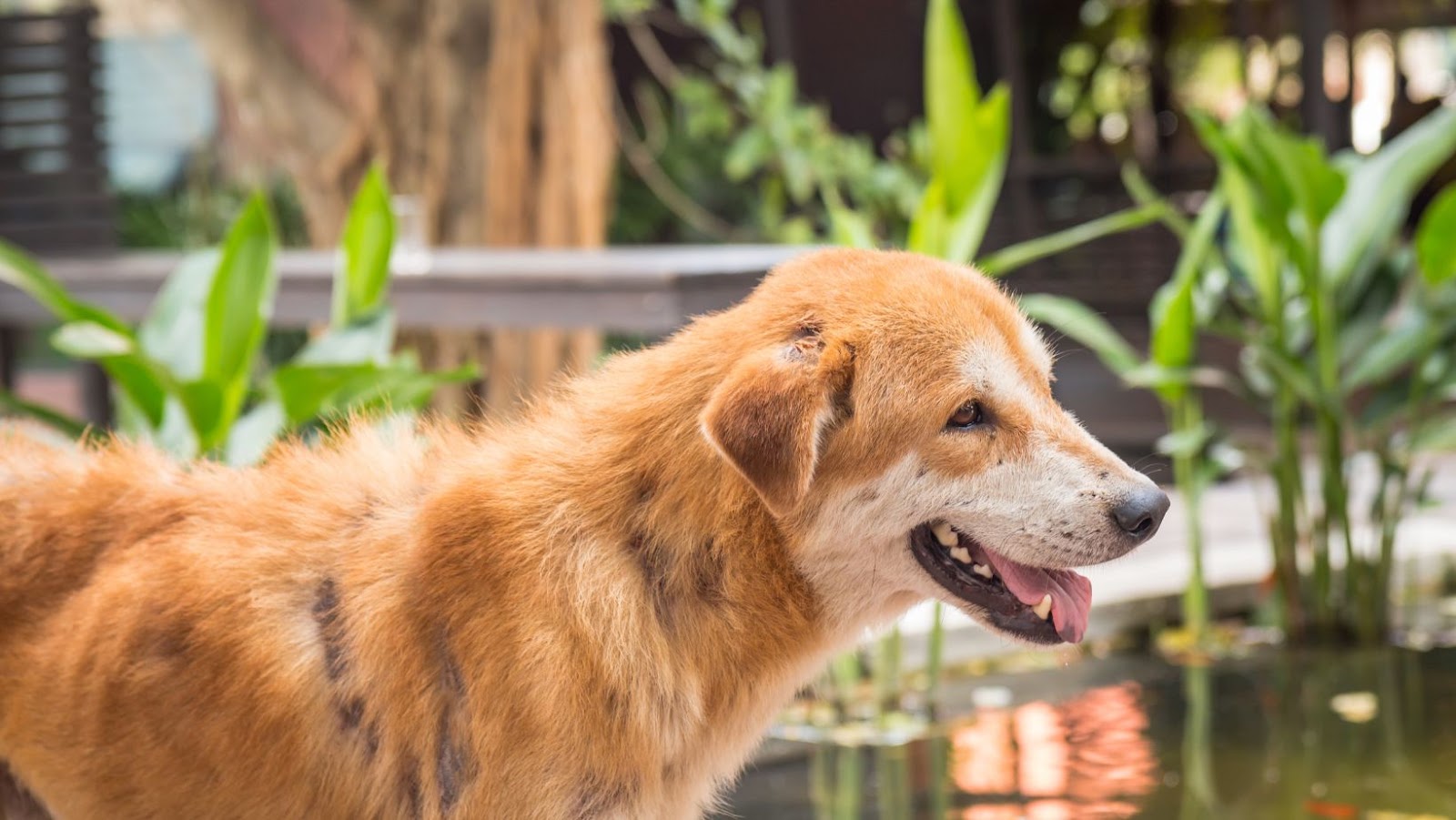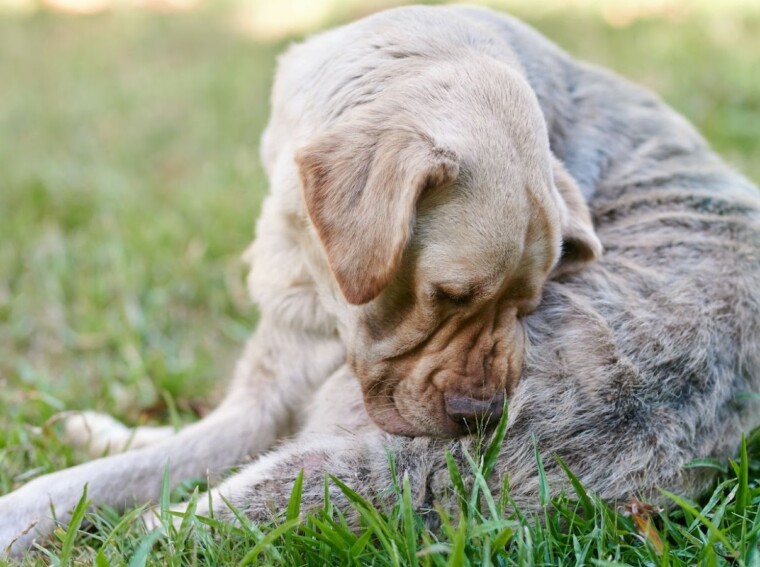To effectively treat dog skin disease scabs, it is important to identify the underlying cause of the condition and treat it accordingly. Common causes of scabs on dogs include allergies, parasites, fungal infections, and skin injuries.
| Here are some general steps to follow: |
| 1. Take your dog to a veterinarian for a proper diagnosis. |
| 2. Follow the veterinarian’s treatment plan, which may include medications, topical treatments or dietary changes. |
| 3. Provide your dog with a clean and comfortable environment to promote healing. |
| 4. Prevent your dog from licking or scratching the scabbed area by using an Elizabethan collar. |
Fact- Scabs on dogs can range in severity from mild skin irritation to a serious health issue, and it’s always best to seek veterinary care if you notice scabs on your pet.
Understanding Scabs
Scabs are often a common skin ailment found in dogs. Scabs can be caused by a variety of things, from environmental causes such as mites, to bacteria and fungal infections. It is important to understand the cause of a scab in order to properly treat it.
In this article, we will delve into the ins and outs of the various causes of scabs, and the various treatments available for them.
犬 皮膚 病 かさぶた 愛情ごはん療法食
There are various reasons why a dog may develop skin scabs, such as allergies, infections, parasites, skin injuries, and autoimmune diseases. Understanding the underlying cause is crucial in determining the appropriate treatment for your dog’s skin scabs.
Allergies: Dogs can develop skin scabs due to environmental or food allergies, which can cause itching and scratching that lead to scab formation. Treatment involves identifying and avoiding the allergens and administering antihistamines or steroids to relieve the symptoms.
Infections: Bacterial or fungal skin infections can result in scabbing, redness, and discomfort. Treatment involves administering antibiotics or antifungal medications, along with medicated shampoos and topical creams.
Parasites: Parasites like fleas, ticks, and mites can cause scabs, hair loss, and skin irritation. Treatment involves administering appropriate parasite control measures, such as topical or oral medications and regular grooming.
Autoimmune diseases: Autoimmune diseases like lupus and pemphigus can cause scabbing and skin lesions. Treatment involves immunosuppressive drugs and topical medications as prescribed by a veterinarian. Proper diagnosis and effective treatment can help alleviate discomfort and prevent further skin damage in dogs with skin scabs.
How Can Scabs Be Identified?
Scabs can be identified as dry or crusty patches of skin that form over a wound or lesion as part of the natural healing process. They can be caused by a variety of factors, including insect bites, allergic reactions, infections, or skin diseases. Scabs may appear red, brown, or black depending on the underlying cause and may be accompanied by itching, pain, or inflammation.
In dogs, scabs can be a sign of a skin disease that requires veterinary attention. Common treatments for scabs in dogs include medicated shampoos, antibiotics, or anti-inflammatory medications. To prevent the formation of scabs, it is important to keep your dog clean and free of parasites, provide a healthy diet, and seek medical attention if you notice any unusual skin changes.
Types of Dog Scabs
It can be difficult to determine the exact type of scab present on your dog, so it is important to consult a professional if your dog has a skin issue. Scabs can be caused by a variety of things, including allergies, bacterial infections, ringworm, and fleas.
Let’s take a look at the most common types of dog scabs and how each one is treated.
Dry and Flaky: Managing Dog Dandruff
Dry and flaky skin in dogs is a common issue that results in dandruff. However, dog dandruff can be managed by keeping the skin moisturised and well-nourished.
One of the most common types of dog skin disease scabs is called hot spots, which are caused by bacterial infection and often result in scabs and hair loss. Treatment involves cleaning the affected area and applying antibiotics or antifungal medication as prescribed by a veterinarian.
Another type of dog scab is called flea dermatitis, which is caused by an allergic reaction to flea bites. Treatment involves flea control and topical medication to relieve itching and inflammation.
A third type of dog scab is caused by ringworm, a fungal infection that results in circular lesions on the skin. Treatment involves oral or topical antifungal medication and keeping the affected areas clean and dry. Pro tip: Regular grooming, a balanced diet, and frequent visits to the vet can help prevent and manage skin issues in dogs.
Moist and Oozing: Treating Hot Spots
Hot spots in dogs are red, moist, and oozing lesions caused by excessive licking, scratching or chewing of the skin. There are several types of dog scabs, but hot spots are more prevalent during hot and humid weather.
Treatment for hot spots begins with cleaning up the affected area daily till it is completely dry. Avoid touching, shaving, or applying any products that can prevent proper airflow. Keep your dog’s fur moisturised using pet-friendly moisturisers and prescribed antibiotics to keep the disease under control, and prevent further damage. For severe cases, consult your veterinarian for a thorough evaluation and observation.
Pro Tip: Constant monitoring of your dog’s skin health can prevent severe skin diseases and reduce the risk of hot spots.
Red and Inflamed: Combating Infection or Allergies
Red and inflamed scabs on your dog may be a sign of an infection or allergies. Identifying the type of dog scab is crucial to determine the best course of treatment for your furry companion.
Here are some common types of dog scabs and how to treat them:
| Type of Scab | Treatment |
| Atopic dermatitis | Antihistamines, steroids, and a change in diet. |
| Flea allergy dermatitis | Flea prevention medication, topical creams, and antibiotics. |
| Pyoderma | Antibiotics and topical medications. |
| Mange | Medications such as Ivermectin, Amitraz, and antibiotics. |
If your dog is experiencing scabs, it is best to consult a veterinarian to determine the underlying cause and receive the appropriate treatment.
Pro tip: Giving your dog a healthy diet and regular baths can prevent many skin issues and keep your dog’s skin healthy.
Crusty and Painful: Healing Mange or Ringworm
Mange and ringworm are two common skin diseases in dogs that cause crusty and painful scabs.

Mange is caused by mites that burrow under your dog’s skin, causing intense itching, redness, and scab formation. Ringworm, on the other hand, is a fungal skin infection that causes hair loss, flaky skin, and crusty scabs.
To treat your dog’s skin disease scabs, follow these steps:
| Take your dog to a veterinarian to determine the underlying cause of the scabs. |
| Administer medication or topical ointments prescribed by the veterinarian to treat the condition. |
| Isolate your dog from other animals to prevent the spread of infection. |
| Clean your home thoroughly and regularly to eliminate any mites and fungal spores that may be present. |
| Protect your dog’s immune system by feeding them a balanced diet and providing ample exercise and rest. |
Natural and Medical Treatments
Dog skin disease scab can be treated medically with the help of steroids, antibiotics, and antifungals, depending on the severity of the condition. There are also a number of natural treatments available which can help to gently soothe the skin and reduce inflammation.
Let’s take a look at the pros and cons of each treatment option.
Natural Home Remedies for Dog Scabs
Dog scabs can be a result of a variety of reasons, such as allergies, flea bites, and infections. A few natural remedies can help alleviate the symptoms associated with these conditions.
| Remedy | Description |
| Aloe Vera | Its anti-inflammatory and soothing properties relieve itchiness and irritation. Apply fresh Aloe Vera gel directly to the affected area. |
| Witch Hazel | It can reduce inflammation and soothe the skin. Apply diluted witch hazel extract directly to the scabs. |
| Apple Cider Vinegar | It has antifungal and antibacterial properties that can help eliminate infections. Mix equal parts apple cider vinegar and water, and apply it to the affected area with a cotton ball. |
| Neem Oil | Its antibacterial and antifungal properties can help treat scabs. Mix a few drops of neem oil with coconut oil and apply it to the affected area. |
| Probiotics | It strengthens your dog’s immune system and helps reduce inflammation. Add probiotics to your dog’s diet or apply yoghourt directly to the scabs. |
These natural remedies can help reduce the severity of dog scabs. However, if the scabs persist or worsen, it is essential to visit a vet for proper medical treatment.
Medications for Healing Dog Scabs
Treating dog skin disease scabs requires a combination of natural and medical treatments that target the underlying cause of the issue.
Here are some medications for healing dog scabs:
| Antibiotics | Antibiotics can be prescribed to treat bacterial infection, which is a common cause of skin disease scabs in dogs. |
| Antihistamines | Antihistamines can be given to alleviate itching and reduce skin inflammation, which can contribute to the formation of scabs. |
| Corticosteroids | Corticosteroids may be used to reduce swelling and inflammation of the skin, which can help promote faster healing of scabs. |
| Medicated shampoos | Medicated shampoos can be used to clean and heal the skin and prevent infection. |
Natural remedies such as coconut oil, aloe vera, and vitamin E can also be used to soothe and heal the skin.
It is important to consult your veterinarian to determine the most appropriate treatment plan for your dog’s skin condition.
Topical Treatments for Soothing Dog Skin
Topical treatments for soothing dog skin can be both natural and medical, depending on the cause of the skin issue. There are many options available for treating dog skin diseases and scabs.
Here are some natural topical treatments:
| Aloe vera: | This plant has natural healing properties that can soothe and moisturise the skin. Apply aloe vera gel directly to the affected area. |
| Coconut oil: | Coconut oil has antibacterial and anti-inflammatory properties that can help reduce itching and irritation. Apply a small amount of coconut oil to the affected area. |
| Oatmeal: | Oatmeal can reduce inflammation and soothe itchy skin. Add finely ground oatmeal to your dog’s bath water or make a paste and apply it directly to the affected area. |
Here are some medical topical treatments:
| Hydrocortisone cream: | This cream can reduce itching and inflammation. Apply a thin layer to the affected area, following the instructions of your veterinarian. |
| Antibiotics: | If the skin issue is due to an infection, antibiotics can be prescribed to treat it. |
It is important to consult with your veterinarian before using any topical treatments on your dog’s skin to ensure that you are using the appropriate treatment for your dog’s specific needs.
Prevention of Dog Scabs
Dog scabs are a skin disease caused by parasites, bacterial infections, and other environmental factors. The good news is, there are preventive measures you can take to ensure your canine friend stays healthy and comfortable.

In this section, we will discuss the different options for preventing dog scab formation and discuss potential treatments for existing scabs.
Maintaining Your Dog’s Diet
Maintaining your dog’s diet is crucial for preventing and treating dog skin disease scabs. A healthy, balanced diet is essential for a dog’s overall health and well-being.
Here are some tips to help maintain your dog’s diet and prevent scabs:
| Feed your dog a well-balanced diet that includes protein, carbohydrates, healthy fats, and essential nutrients. |
| Avoid feeding your dog table scraps and human food that can be harmful and cause skin irritations. |
| Make sure your dog is drinking enough water to keep the skin hydrated and prevent dryness. |
| Consider incorporating skin-boosting supplements like omega-3 fatty acids, vitamin E, and biotin to your dog’s diet. |
| If your dog already has scabs, consult with your veterinarian to determine the underlying cause and appropriate treatment plan, which may include dietary changes as well. |
By maintaining a proper diet, pet owners can help improve their dogs’ health and prevent skin infections like scabs.
Pro-tip: Incorporate fresh fruits and vegetables into your dog’s diet as healthy treats and to increase the intake of essential vitamins and minerals.
Grooming Practices That Prevent Dog Scabs
Scabs on your dog’s skin can be uncomfortable and painful, and it’s essential to take preventative measures to avoid them. Here are some grooming practices that can help keep your dog’s skin healthy and prevent scabs:
| Regular brushing: | Frequent brushing helps remove dirt, dander, and dead hair from your dog’s coat, which can cause skin irritation and scabs. |
| Bathing and drying: | Regular bathing helps keep your dog’s coat clean and healthy, preventing scabs caused by skin infections. It’s also crucial to dry your dog thoroughly after a bath to prevent moisture from building up. |
| Healthy Diet: | Proper nutrition helps keep your dog’s immune system strong, which can prevent scabs and other skin issues. |
| Inspection: | Regularly inspect your dog’s skin for scabs, bumps, or any unusual growth. If you notice anything concerning, consult with your veterinarian immediately. |
With these grooming practices, you can help prevent scabs and other skin issues in your dog and promote their overall health and wellness.
Pro Tip: Always use dog-specific grooming products and avoid harsh chemical-based shampoos or soaps.
Maintaining a Clean Environment
Maintaining a clean environment is crucial in preventing and treating dog scabs and other skin diseases. Here are the essential steps you need to take:
| Bathe Your Dog: | Regularly bathing your dog helps to remove dirt, bacteria, and other toxins that may cause skin irritation and scabs. Use lukewarm water and a mild shampoo that suits your dog’s skin. |
| Brush Your Dog’s Coat: | Routinely brushing your dog helps to remove loose hair, dead skin cells, and other debris. It also promotes healthy circulation of blood and natural oils through the skin and fur. |
| Clean and Disinfect Your Home: | Ensure your dog’s sleeping area, toys, feeding bowls, and other items are clean to prevent the spread of bacteria and other irritants. Clean with pet-safe products, and disinfect regularly. |
| Consult With Your Vet: | When you notice scabs or other skin problems, contact your vet immediately. Don’t attempt to use OTC remedies without first consulting a vet. Professional health advice is essential. |
Pro Tip: Proper grooming and cleaning are essential for the overall health and wellness of your dog. Regular health check-ups and a balanced diet also help to prevent skin problems.
When to Seek a Professional
If your dog is suffering from the skin disease scab, it is important to determine when to seek a professional for treatment. In some cases, the condition can be managed with home remedies, while other times it might require veterinary intervention. Knowing when to seek a professional and what kind of treatment is available can help you give your dog the best care possible.
Identifying When Dog Scabs Need Veterinary Attention
Dog scabs are a common occurrence and may not always require veterinary attention. However, certain signs indicate that it’s time to seek professional medical help.
Here are some signs that indicate you should consult a vet:
| Sign | Explanation |
| Large, stubborn scabs that won’t heal | If your dog’s scabs are not healing despite your best efforts, it is a sign that you should seek medical attention. |
| Red and swollen skin | If your dog’s skin is red, swollen, or painful to the touch, it could be a sign of an underlying skin condition, which must be diagnosed and treated by a vet. |
| Hair loss | If your dog has hair loss around the scabs or other areas, it could be a sign that the underlying condition is worsening, and you should seek veterinary attention immediately. |
Any scab that is accompanied by lethargy, decreased appetite, or other signs of ill health warrants a trip to the vet. Seek medical attention immediately if you observe any of the above signs.
Treatment Options When Beyond the Scope of Home Remedies
When home remedies fail to treat your dog’s skin disease scab, it’s time to seek professional treatment options from your veterinarian.

Although some cases of skin diseases in dogs can be treated with home remedies, others require more extensive care. Signs that your dog’s skin condition requires professional treatment include excessive itching, oozing or crusting sores, fever, lethargy, loss of appetite, and hair loss.
Your veterinarian may recommend one or a combination of the following treatments:
| Treatment | Description |
| Antibiotics or antifungal medications | These medications can fight bacterial and fungal infections and clear up the scab. |
| Immunosuppressive drugs | These drugs can calm down your dog’s overactive immune system, which may be causing the skin disease. |
| Omega-3 fatty acids | A diet high in omega-3 fatty acids can help reduce inflammation and itching. |
| Surgical removal | In some cases, surgical removal of the affected tissue may be necessary to promote healing. |
It’s important to follow your veterinarian’s instructions carefully to ensure the best possible outcome for your pet.
